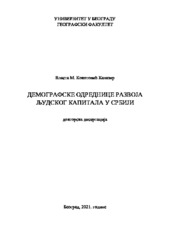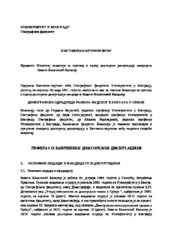Приказ основних података о дисертацији
Демографске одреднице развоја људског капитала у Србији
Demographic determinants of human capital development in Serbia
| dc.contributor.advisor | Vojković, Gordana | |
| dc.contributor.other | Gligorijević, Vera | |
| dc.contributor.other | Radivojević, Biljana | |
| dc.creator | Kokotović Kanazir, Vlasta | |
| dc.date.accessioned | 2022-09-06T14:04:56Z | |
| dc.date.available | 2022-09-06T14:04:56Z | |
| dc.date.issued | 2021-09-16 | |
| dc.identifier.uri | https://uvidok.rcub.bg.ac.rs/bitstream/handle/123456789/4377/Referat.pdf | |
| dc.identifier.uri | https://eteze.bg.ac.rs/application/showtheses?thesesId=8737 | |
| dc.identifier.uri | https://fedorabg.bg.ac.rs/fedora/get/o:26319/bdef:Content/download | |
| dc.identifier.uri | https://plus.cobiss.net/cobiss/sr/sr/bib/46322185 | |
| dc.identifier.uri | https://nardus.mpn.gov.rs/handle/123456789/20635 | |
| dc.description.abstract | Људски капитал представља један од битних фактора за одређивање друштвеног и економског развоја. Неједнакост у образовању доводи до неједнакости на тржишту рада што има за последицу дугорочно не искоришћеност људског капитала, а самим тим и смањену продуктивност. У другој половини двадесетог века дошло је до повећања потреба за квалитетнијом тј. образованијом радном снагом, што је условило повећање броја лица која се школују. Лица са већим степеном школске спреме, имају бољи приступ тржишту рада и већу могућност запослења. Ипак, и поред многобројних студија на тему нивоа и квалитета образовања, ова тема се и даље сматра недовољно истраженом. Као разлог за то, најчешће се наводи недостатак адекватних података или проблем њихове упоредивости, као и различитост образовних система од земље до земље. Циљ дисертације је утврђивање стања људског капитала у Србији, његових демографских одредница и сагледавање детерминанти људског капитала кроз ширу перспективу увођењем и других димензија од значаја за свеукупни друштвени и економски развој. Истраживање је спроведено на простору Републике Србије и обухватило је 168 општина. Стање људског капитала посматрано је кроз достигнути ниво образовања сагледавањем трендова у нивоу школске спреме на основу пописних резултата у периоду од 1981. до 2011. године. Демографске одреднице људског капитала анализиране су избором најважнијих демографских карактеристика попут старости, пола, економске активности, а одређивање просторних диспаритета у нивоу људског капитала сагледано је кроз анализу нивоа школске спреме према популационој величини општина. Детерминанте развоја људског капитала анализиране су методом композитних индекса које поред образованости укључују и демографску и социо- економску перспективу. Према добијеним вредностима индекса издвојени су типови општина за сваку од анализираних области (демографија, образовање, социо-економски услови). На основу компонентиних индекса креиран је композитни Индекс развијености људског капитала, и на основу његових вредности издвојено је шест типова општина (три типа са релативно повољним вредностима и три са неповољним вредностима људског капитала). Евалуација стања развијености људског капитала може послужити као смерница у даљем преузимању акција са циљем адекватне популационе политике на локалном нивоу, усклађивања понуде образовања и потреба тржишта рада и успоравања процеса емиграције младог, високообразованог становништва. | sr |
| dc.description.abstract | Human capital is one of the important factors in determining social and economic development. Inequality in education leads to inequality in the labor market, which results in longterm underutilization of human capital, and thus reduced productivity. In the second half of the twentieth century, there was an increase in the need for more quality and educated labor, which led to an increase in the number of people attending school. People with a higher level of education have better access to the labor market and a greater possibility of employment. However, despite numerous studies on the level and quality of education, this topic is still considered insufficiently researched. The reason for that is most often the lack of adequate data or the problem of their comparability, as well as the diversity of education systems between countries. The aim of the dissertation is to determine the state of human capital in Serbia, its demographic determinants and to consider the determinants of human capital through a broader perspective by introducing other dimensions, important for the overall social and economic development. The research was conducted on the territory of the Republic of Serbia and included 168 municipalities. The state of human capital was observed through the achieved level of education by looking at trends in the level of education, based on the Census results in the period from 1981 to 2011. Demographic determinants of human capital were analyzed by selecting the most important demographic characteristics, such as: age, gender and economic activity. Determining of spatial disparities in the achieved level of human capital was seen through the education analysis, according to the municipality’s population size. The determinants of human capital development were analyzed using the method of composite indices, which, in addition to education, also include a demographic and socio-economic perspective. According to the obtained values of the index, the types of municipalities were separated for each of the analyzed areas (demography, education, socio-economic conditions). Based on the component indices, a composite Human Capital Development Index was created, and based on its values, six types of municipalities were highlighted (three types with relatively favorable values and three with unfavorable values of human capital). Evaluation of the human capital development can serve as a guideline in further action with the aim of adequate population policy at the local level, harmonizing the supply of education and the needs of the labor market, which will decelerate the emigration of young, highly educated population in future. | en |
| dc.format | application/pdf | |
| dc.language | sr | |
| dc.publisher | Универзитет у Београду, Географски факултет | sr |
| dc.rights | openAccess | en |
| dc.rights.uri | https://creativecommons.org/licenses/by-nc-nd/4.0/ | |
| dc.source | Универзитет у Београду | sr |
| dc.subject | људски капитал | sr |
| dc.subject | human capital | en |
| dc.subject | демографија | sr |
| dc.subject | образовање | sr |
| dc.subject | социо-економски услови | sr |
| dc.subject | Србија | sr |
| dc.subject | demography | en |
| dc.subject | education | en |
| dc.subject | socio-economic conditions | en |
| dc.subject | Serbia | en |
| dc.title | Демографске одреднице развоја људског капитала у Србији | sr |
| dc.title.alternative | Demographic determinants of human capital development in Serbia | en |
| dc.type | doctoralThesis | |
| dc.rights.license | BY-NC-ND | |
| dc.identifier.fulltext | http://nardus.mpn.gov.rs/bitstream/id/145493/Izvestaj_Komisije_12443.pdf | |
| dc.identifier.fulltext | http://nardus.mpn.gov.rs/bitstream/id/145492/Disertacija_12443.pdf | |
| dc.identifier.rcub | https://hdl.handle.net/21.15107/rcub_nardus_20635 |



